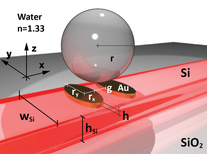Optical forces arising from light-matter interaction as the result of their momentum exchange are the main characters acting in the theatre of optical trapping systems. Arthur Ashkin demonstrated in 1970 that, thanks to the radiation pressure, it is possible to trap small particles released into a liquid when two counterpropagating laser beams were focused on these small objects. In dielectric systems, the tweezing action undergoes the diffraction limit which prevents subwavelength objects from being firmly trapped. Furthermore, plasmonic structures are able to concentrate light in deep subwavelength volumes and represent an enticing alternative to overcome the limits of a dielectric system. This occurs thanks to surface plasmon polaritons and localized surface plasmons at the interface between a dielectric material and noble metal nanoparticles. By taking advantage of plasmonic resonators inside tweezing systems, very deep and narrow potential energy wells can be tailored to achieve stable optical tweezing down to subwavelength particles. In this purpose, we propose intregrated plasmonic tweezers consisting in a gold MNPs chain composed of nanocylindrical particles placed on top of a siliconon- insulator (SOI) waveguide. The strong coupling occurring between the SOI waveguide and the plasmonic structure enables a giant excitation of the MNP chain near field. This efficient near-field excitation leads to a very efficient tweezing of nearby nanobeads. Optical tweezers and manipulators for nano- and microparticles are of great interest for biological or environmental analysis. Main requirements for such devices are the operation at ambient temperature, with low energy consumption, and addressing a wide range of particle size and nature.
